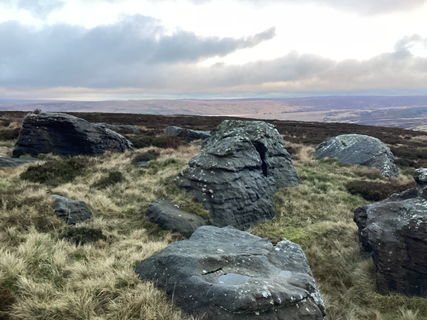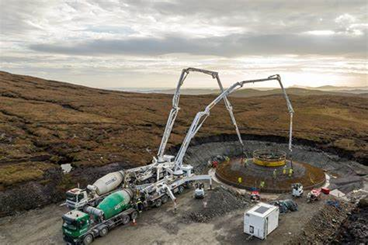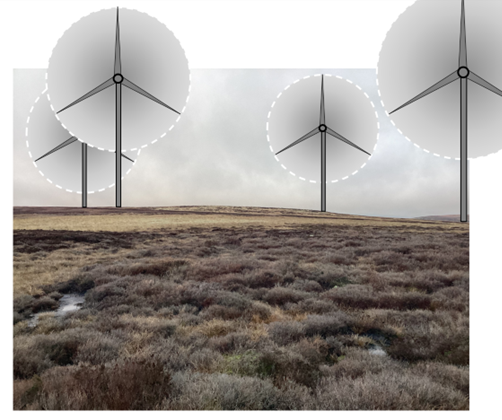
Nick MacKinnon is a freelance teacher of Maths, English and Medieval History, and lives above Haworth, in the last inhabited house before Top Withens = Wuthering Heights. In 1992 he founded the successful Campaign to Save Radio 4 Long Wave while in plaster following a rock-climbing accident on Skye. His poem ‘The metric system’ won the 2013 Forward Prize. His topical verse and satire appears in the Spectator, and his puzzles and problems in the Sunday Times and American Mathematical Monthly. Email: nipmackinnon@gmail.com
In 2018 Mark Avery and his crowd-funders won a victory on Walshaw Moor in West Yorkshire, between Hebden Bridge and the Brontë stronghold of Haworth. Natural England were persuaded that a proposed track across the moor would result in “a significant loss when considering the total resource across the site and the importance of this habitat in the national and international context.” (click here).
Now, in January 2024, there is a ‘suck it and see’ scoping proposal in front of Calderdale Council for 65 wind turbines on Walshaw Moor, on the same land owned by Richard Bannister. Mark has kindly given space for a guest blog about the moor. Every fortnight I shall walk to one of the proposed turbine sites and write about it, and how the campaign is developing.
We have started with a burst of stories in the national and local papers (Halifax Courier 15/12/23, Guardian 8/1/24, Daily Mail 8/1/24, 14/1/24, Keighley News 11/1/24) but we may have to work against this development, and its successors, for decades, so these blogs will be patient. We don’t have to say everything all at once.
Turbine 11: Mere Stones (grid reference: SD 953 343, what3words /// landscape.puncture.reverted)

10 January 2024 It has been raining since October, but this has been a colder week. I walk up to Mere Stones from the Widdop road. The charisma of this landscape is vibrant in the cloughs and edges, at Hardcastle Crags or Lumb Hole, in the masonry achievement of Hebden Bridge and the community sustained there, but the unemphatic power of Walshaw catchment is obscure to me as I catwalk up the inches-wide path across Sutcliffe Rough. By comparison, Greave Pasture is like a sheep-mown lawn. The farmer, the only person I will see, is feeding his flock, and calls “ ’Ow do?” as I pass. His pick-up moves at less than walking pace on the smooth rut-way up the side of Greave Clough. I am anxious about finding the Stones, but the boundary wall of the pasture is as clear on the ground as on the map. A couple of minutes further on, a quad-bike track has been ironed into the moor like the crease in a sergeant-major’s trousers, and heads directly to the Stones.

The name “mere” comes from the Old English gemære = boundary, and these weathered stones would have been welcome to a medieval surveyor, describing the limits of some feudal holding in this stark landscape. Underfoot there is some sphagnum moss, but black peat glistens in four o’clock light under a film of oily water. It should not be visible, and is emitting CO2. Suddenly the ground levels out onto the site of Turbine 11.
On the West Riding moors, you get this sudden understanding of their grandeur as you cross the 430-metre contour. Your eyeline runs to places far off at the same height: some, like Stoodley Pike drawing the eye like lightning to steel; most offer the flat roof you are standing on. The foreground skims across the dale to find another flat landing, and another, the whole responding to the horizontal planes in the millstone grit, that can still be seen in the Mere Stones, laid down as sandbanks in a vast river delta in the Carboniferous. I take ten minutes to walk round the circumference of what I imagine may be the scar of the foundation of a turbine. The photograph below, of the new Viking wind farm in Shetland, shows what this could look like, and what3words supplies its own accidental poetry: /// landscape.puncture.reverted.

Much of my walk today is likely to be overlaid with a ‘floating’ access road, and at its end will be a puncture wound, stanched with concrete (click here). The turbines will cluster here. Looking north, with your back to T11, T13 and T15 will jostle in the view in front of T21 and T18 on Heather Hill, less than a mile away.

The light is going as I walk down, and the sullen glimmer on Gorple slips away. The far side of Greave Clough is criss-crossed with the rectangular stigmata of burnt heather. I live on the moor above Stanbury, where Mr Bannister owns the shooting rights, but not the land, and am used to these scars, but the regime of burning here is of a different magnitude. In later blogs I shall describe the management history. This degraded surface on a steep clough-side will allow runoff to accelerate (see here).
Then, without wanting to, I find I am thinking like a curlew. “I won’t nest anywhere near those two sycamores: crows.” Recent science (click here) shows that curlews avoid nesting in a buffer zone 500m from a turbine. The brown circle on the map is an example of what we shall call the Curlew Exclusion Zone. Walshaw Moor is a breeding stronghold for ground-nesting birds and gamekeepers are proud of the incidental protection a ‘managed’ moor offers to the eggs and chicks of skylarks, lapwings, short-eared owls, meadow pipits, and curlews. Draw a brown circle round every turbine and there is no moor left. None of these species, some critically endangered to the point of extinction, will nest in the punctured industrialised landscape that Mr Bannister is proposing.
I take a bearing off the scrappy plantation to find the path across the rough, following the tug of gravity which will accelerate the storm surge over turbine pads, impacted ducts and service roads, into Graining Water and barrelling towards Hebden Bridge and Mytholmroyd.
Turbine 11: The Mere Stones
We do not know what boundary they marked,
but let’s believe for now they split the point
where earth meets sky.
Something of an animal here, crouched
among the pelt of moorland.
A dappled beast, hide-burned,
the stones low lying and silent.
Bedded in moss and peat,
keepers of clough and sike,
waiting and tongue-tied.
Lydia Macpherson
Lydia Macpherson’s collection, ‘Love Me Do’ is published by Salt. Her ancestors farmed Top Withens, whose location is believed to have inspired Emily Brontë’s ‘Wuthering Heights’.
This is the the 1st in a series of 65 guest blogs on each of the wind turbines which Richard Bannister plans to have erected on Walshaw Moor.
[registration_form]
It is some consolation that this barbarous proposal has stirred the land and the voices of its poets are raised in defiance.
Richard – thank you for what appears to be your first comment on this site.
Thanks Richard!. I hope you will be in touch to do a Turbine yourself.
Beautiful, beautiful words rising up to defend this threatened land. They must be read by all people everywhere. Writers must be joined on the barricades by readers.
Sharon – thank you for what appears to be your first comment on this site.
Thank you Sharon!
Very evocative Nick and Lydia. When I first heard of this proposed facility, most voices were of a “Good, we need renewables “ ilk. I’m glad we have such prose on our side , highlighting what could be lost!
Graham – thank you for what appears to be your first comment on this site.
Thank you Graeme! I’m going for a walk with Bob Berzins a peat expert next week and I hope he will start to unpack the CO2 calculation for this wind farm, which is on protected peat and covered by the highest designations of protection.
Great blog. This vandalism cannot be allowed to happen. What is at stake: environmentally, culturally, and so on, is too important to lose.
Michael – thank you for what appears to be your first comment on this site.
Thanks Michael. I think you must be the author of “Walking the Invisible” on the Bronte landscapes. Hope you do one of these blogs soon.
Heart breaking to even contemplate the many levels of destruction and devastation this industrial scale proposal will cause. The sheer bloody minded disregard for many important benefits within the site is criminal, shame on you Richard Bannister!!!
Lesley – thank you for what appears to be your first comment on this site.
Thank you Lesley. We will stop Mr Bannister as he has been stopped before!
for birds, it would be good to see the actual data, times, and details, and who the surveyors were- part of expected full disclosure in line with standard guidance- in order to test the suitability/ robustness of the data. The report almost suggests that :
“6.6 Additional proposed surveys”
doing a second year of surveys is them being extra good. It is not. It is in line with SNH guidance they say they are using. SNH/NatureScot requires 2 years of data
Access to the whole data set is critical for testing assertions and data suitability
Indeed. We have among us (though I am not of them) people who will understand the deficiencies of the developer’s bird work far better than Planning at Calderdale, provided we are allowed to see it.
Did you (skim) read the linked paper cited in the blog on bird avoidance of turbines? I bet your understanding of it was far greater than mine. Get in touch if you would like to be a bird consultant in the campaign. nipmackinnon@gmail.com
Great blog. I’ll email to offer my support. Notts Trent University published this paper in 2023 on The Extent of Windfarm Infrastructures on Recognised European Blanket Bogs: https://www.nature.com/articles/s41598-023-30752-3
So Walshaw isn’t the only one. The paper is largely a statistical analysis but does say “evidence supports negative impacts of Windfarm development on this critical habitat”.
The proposal is contradictory in so many ways and it’s blatant green-washing to suggest the planting of 300,000 trees on an estate which is almost entirely upland heath and blanket bog. The right tree in the right place definitely – and that’s not the right place for 300,000 trees or 65 giant wind turbines.
Access roads for 40 tonne concrete lorries won’t be floating – they’ll have to cut through 2 metres of blanket bog to the bedrock below to support that weight.
The proposal only covers about half Walshaw Estate so we can expect more proposals for more turbines. Plenty more to say!
Looking forward to our walk on 30th Bob!
Nick, this is a wonderful blog post, and I was especially moved by your thinking like a curlew. I too love walking on Walshaw Moor and would be happy to accompany you on one of your ‘turbine’ walks sometime, assuming you want company (& I fully understand if you don’t! The power of this landscape is arguably augmented by solitude). It is vital we stop this proposed desecration!
Ali – thank you for what appears to be your first comment on this site.
Hi Ali! Thank you. Let’s do one soon and we can write the blog together! I’m doing them at about two a week at the moment to save enough up to cover the ground nesting bird season, when many of these sites will be super sensitive and undisturbed. My email is nipmackinnon@gmail.com
Thanks Ali! Let’s go for a walk soon and write one together!
Hi Nick, great, yes, I’ll email you
Thank you Nick. Beautiful yet heartbreaking words. The sentence “Draw a brown circle round every turbine and there is no moor left.” perfectly summarises the magnitude of this proposed butchery of our moorland.
NO to the Wuthering Windfarm!
Zoe – thank you for what appears to be your first comment on this site.
Thanks Zoe! When I read yours I realised I have to put a new curlew EZ circle on the map as each turbine is visited, so when we’ve done all 65 … there won’t be any moor left.
Beautiful writing which evokes the moors here and the shadow of more destruction.
Thanks Andy. Yes. If this one gets through it will be Gorple next, then Oakworth/Keighley and the wild land from Todmorden to Silsden , crossed by just two narrow roads, will be gone.
Thanks Andy! Nick
Thanks Andy. Agreed. If this one gets through, despite being on Natura protected peat then there is nothing to stop a wind farm stretching from Todmorden to Silsden over the terrific wedge of wild land that is crossed by just two narrow roads.
The developers have told the hilltop parish councillors’ “forum” that the proposed Calderdale WInd Farm is a test case and the most important of the 7 wind farm applications they’re making, although they’ve not said where the other ones are.
There are plenty of alternative sites available for windfarms without damaging precious peat moorland and heritage landscapes. This development must not be allowed to progress.
It is so much easier to change planning laws so that every new build is triple glazed, well insulated and equipped with its own solar panels. similarly industrial new builds should have full solar panels on roof, grey water catchment and re-use and be built on brown field sites.
Chris – thank you for what appears to be your first comment on this site.
I agree with you – and this site has the highest protective designations available in the UK and so anyone seeking to get planning permission for such a large development must know that their chances of success are low. But the decision on this proposal will, of course, be made on the merits of its case (which I judge to be poor) and not on ‘the planning system should be doing lots of other things instead’ – but I agree with you that the planning system should be taking a much greater part in getting renewables on roofs etc.
When I first moved to Haworth I thought the moors were bleak and inhospitable but by exploring them I learned to love the harshness and the feeling of being on top of the world, almost like flying. Lying down in the heather listening to the skylarks whilst flying a kite is a favourite memory.
I look forward to more of your Blogs, but wish the reason behind them did not exist.
I am from the West Midlands and was enjoying a walk last week with my son. We walked from Haworth to Top Withens and back. On the gates of Upper Heights Farm there was a notice board showing the detail of the Calderdale Wind Farm proposals. This shocked us and I have now written to protest to the address on the notice board.
I do think that there should be more of these notice boards on the well used route to Top Withens to alert people like myself who were not aware of what is proposed.